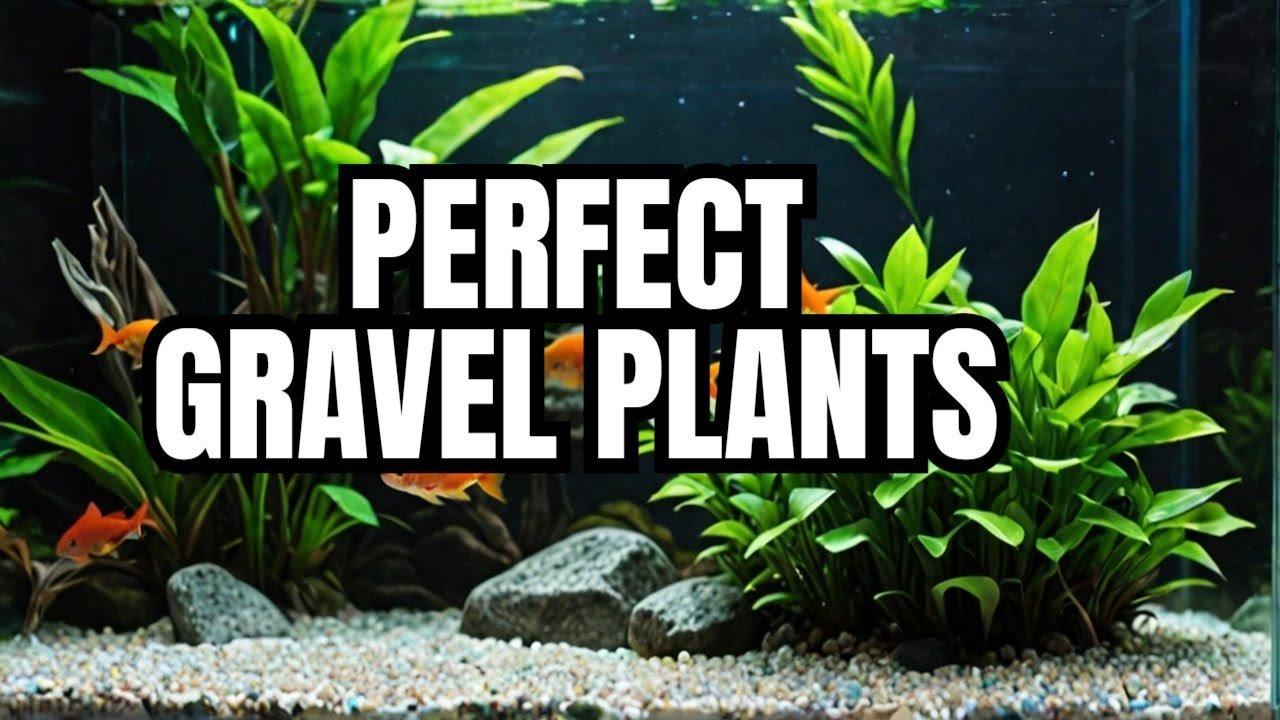Planting aquarium plants in gravel is simple and rewarding. It improves tank aesthetics and benefits fish.
First, choose suitable plants. Some plants thrive in gravel better than others. Gravel provides a stable base for plants. It allows roots to anchor firmly. Healthy plants need good light and nutrients. Ensure your tank has both. Gravel does not hold nutrients well, so you may need to add fertilizers.
Root tabs are a good option. Proper planting technique is key. Bury the plant roots gently in the gravel. Avoid damaging them. Space the plants for growth. This helps them thrive and prevents overcrowding. With care, your aquarium will flourish. Enjoy the beauty and health benefits of planted aquarium gravel.

Credit: www.youtube.com
Choosing The Right Plants
Planting aquarium plants in gravel involves selecting species that thrive in such conditions. Gently push roots into the gravel, ensuring they are well-covered. Regularly check for growth and health.
Choosing the right plants for your aquarium is crucial. The right plants can enhance the look and health of your tank. Not all plants thrive in gravel. Some need special substrates or care. Understanding which plants will work best in gravel can save you time and money.Popular Aquarium Plants
Java Fern is a popular choice. It is hardy and adaptable. Anubias is another great option. It grows well in low light and gravel. Amazon Sword is also favored. It has broad leaves and adds a lush look.Plant Compatibility
Not all plants get along. Some need more light, some need less. Consider the needs of each plant. Also, think about your tank’s inhabitants. Fish and plants must coexist peacefully. Some fish may eat or uproot plants. Choose plants that are safe and suitable for your fish. “`Credit: www.plantedtank.net
Selecting The Gravel
Choosing the right gravel is crucial for a healthy aquarium. The gravel provides a base for plant roots and helps anchor them. It also affects water chemistry. Let’s discuss the types and sizes of gravel suitable for your aquatic plants.
Gravel Types
There are different types of gravel for aquarium plants. Pea gravel is common. It is small and rounded. It allows water to flow easily. Another type is specialized plant gravel. It contains nutrients. This helps plants grow strong. Some hobbyists use river gravel. It is natural and looks beautiful.
Gravel Size
Gravel size matters too. Small gravel, about 2-4 mm, is ideal. It supports plant roots well. Large gravel can be tricky. It leaves gaps. Roots may not anchor properly. Fine gravel, like sand, packs too tightly. It restricts water flow. This can lead to root rot. Choose the right size for healthy plants.
Preparing The Tank
Creating a healthy environment for your aquarium plants is crucial. Begin by preparing the tank properly. This ensures a strong start for your plants. Follow these steps to get everything ready.
Cleaning The Gravel
Start with clean gravel. Rinse it thoroughly under running water. Remove any dust and debris. Use a colander for easy rinsing. Make sure the water runs clear. Clean gravel helps prevent harmful bacteria.
Setting Up The Substrate
Choose a nutrient-rich substrate. This provides essential nutrients for plant growth. Layer the substrate at the bottom of the tank. Aim for a depth of 2-3 inches. Add gravel on top for stability. This helps anchor the plants securely.
Ensure even distribution of the substrate. This prevents uneven plant growth. Use your hands to level it out. Create a gentle slope for a natural look. Your tank is now ready for planting.
Planting Techniques
Planting aquarium plants in gravel requires specific techniques to ensure their growth. The right method can create a beautiful and healthy underwater garden. Let’s explore how to plant both stem and rooted plants in gravel.
Planting Stem Plants
Stem plants are popular for their vibrant colors and quick growth. Follow these steps to plant them in gravel:
- Prepare the Plants: Trim the lower leaves to expose the stem.
- Create Holes: Use your finger or a stick to make small holes in the gravel.
- Insert the Stems: Place the stem into the hole, ensuring the bottom part is buried.
- Cover with Gravel: Gently cover the base of the stem with gravel.
Be careful not to damage the stems. Plant them with enough space for growth.
Planting Rooted Plants
Rooted plants have a more complex root system. They anchor well in gravel. Here’s how to plant them:
- Prepare the Roots: Trim any damaged roots.
- Create a Larger Hole: Dig a larger hole in the gravel for the roots.
- Place the Plant: Insert the plant into the hole, spreading the roots.
- Cover with Gravel: Cover the roots with gravel, leaving the base exposed.
Ensure the roots are well-spread. This provides stability and nutrients.
| Plant Type | Steps |
|---|---|
| Stem Plants |
|
| Rooted Plants |
|
These techniques ensure your aquarium plants thrive in a gravel substrate. Happy planting!
Providing Nutrients
Providing the right nutrients is crucial for the healthy growth of aquarium plants. Plants need essential nutrients to thrive, just like any other living organism. These nutrients help in the development of strong roots, vibrant leaves, and overall plant health. There are a couple of effective methods to ensure your aquarium plants get the nutrients they need.
Using Fertilizers
Fertilizers are an excellent way to supply nutrients to your aquarium plants. Liquid fertilizers can be added directly to the water. They contain essential elements like nitrogen, phosphorus, and potassium. These elements promote growth and keep the plants healthy. Remember to follow the dosage instructions on the fertilizer package.
Over-fertilizing can harm your plants and fish. Start with a small amount and monitor the plants’ response. Adjust the dosage if needed. Regularly check the water quality to prevent any imbalance.
Adding Root Tabs
Root tabs are another great option to provide nutrients to your aquarium plants. These tabs are inserted into the gravel near the plant roots. They slowly release nutrients, ensuring a steady supply. Root tabs are ideal for plants that have strong root systems.
Place the root tabs close to the plant base, but not directly on the roots. This placement helps the plants absorb nutrients efficiently. Replace the tabs every few months for consistent nutrient supply. Always read the instructions to know the correct usage frequency.
Ensuring Proper Lighting
Ensuring proper lighting is crucial for the health of aquarium plants. Without the right light, plants will not thrive. They need light for photosynthesis, which helps them grow. Proper lighting also enhances the beauty of your aquarium.
Light Intensity
Light intensity affects the growth of your aquarium plants. Different plants need different light levels. High-light plants require intense light. Low-light plants need less intense light. Check the needs of your specific plants before choosing your lights.
Light Duration
Light duration is also important for plant health. Most aquarium plants need 8-10 hours of light each day. Too much light can cause algae growth. Not enough light can weaken the plants. Use a timer to control the light duration. This helps maintain a consistent light schedule.
Maintaining Water Quality
Maintaining water quality is crucial for the health of your aquarium plants. Poor water quality can lead to unhealthy plants and fish. Here are some key aspects to consider:
Water Parameters
Keeping the right water parameters is essential for plant growth. Ensure the pH, temperature, and hardness are suitable for your plants. Most aquarium plants thrive in a pH range of 6.5 to 7.5. The ideal temperature is between 72°F and 82°F. Hardness should be kept at 3 to 8 dKH.
| Parameter | Ideal Range |
|---|---|
| pH | 6.5 – 7.5 |
| Temperature | 72°F – 82°F |
| Hardness | 3 – 8 dKH |
Regular Water Changes
Performing regular water changes is vital for maintaining water quality. Change 10-20% of the water every week. This helps remove toxins and replenish nutrients. Use a water conditioner to treat tap water before adding it to the tank.
- Change 10-20% of water weekly
- Remove toxins and replenish nutrients
- Use a water conditioner for tap water
Regular water changes also help control algae growth. Algae can compete with your plants for nutrients and light. By maintaining clean water, you support healthy plant growth.

Credit: www.reddit.com
Caring For Your Plants
Once you’ve planted your aquarium plants in gravel, it’s important to care for them properly. Healthy plants make your aquarium beautiful and create a better environment for your fish. Regular maintenance ensures that your plants thrive. Below, we delve into two key aspects of plant care: pruning techniques and dealing with algae.
Pruning Techniques
Pruning is essential for maintaining plant health and appearance. It helps plants grow strong and prevents overgrowth. Here are a few techniques:
- Trim dead leaves: Remove dead or yellowing leaves to prevent decay.
- Cut back overgrowth: Trim plants that grow too tall or wide.
- Use sharp scissors: Sharp tools make clean cuts and reduce plant damage.
Regular pruning promotes healthy growth. It also helps light reach lower parts of the plants.
Dealing With Algae
Algae can quickly become a problem in your aquarium. It competes with plants for nutrients and light. Here are some ways to manage algae:
| Method | Description |
|---|---|
| Control light | Limit light to 8-10 hours a day. |
| Regular cleaning | Remove visible algae during water changes. |
| Add algae eaters | Fish like Siamese algae eaters help control algae. |
By managing algae, you ensure your plants get the resources they need. Healthy plants keep your aquarium looking vibrant.
Frequently Asked Questions
What Tools Do I Need To Plant Aquarium Plants In Gravel?
To plant aquarium plants in gravel, you need tweezers, scissors, and a substrate fertilizer. These tools help you plant efficiently and ensure proper growth.
Can You Plant Aquarium Plants Directly Into Gravel?
Yes, you can plant aquarium plants directly into gravel. Ensure the gravel is nutrient-rich and the plants’ roots are securely anchored.
How Deep Should I Plant Aquarium Plants In Gravel?
Plant aquarium plants in gravel to a depth of about 2-3 inches. This helps stabilize the plants and promotes healthy root growth.
Do Aquarium Plants Need Special Lighting?
Yes, aquarium plants need special lighting. Use full-spectrum LED lights to mimic natural sunlight and encourage plant growth.
Conclusion
Planting aquarium plants in gravel can be simple and rewarding. Follow the steps carefully. Choose the right plants for your tank. Prepare the gravel properly. Planting takes patience, so take your time. Ensure proper lighting and nutrients. Regular maintenance keeps plants healthy.
With effort, your aquarium will thrive. Enjoy the beauty and benefits of a planted tank. Happy planting!





